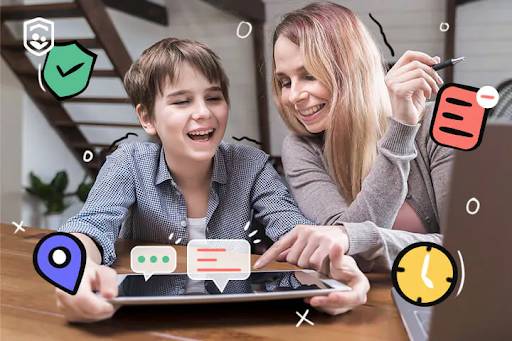The internet has become an essential part of our daily lives. It's a vast resource of information, entertainment, and communication. But with its benefits come significant risks, especially for children. As a parent, you want to make sure your kids are safe when they're online, and that's where parental control comes into play. This article will explore what parental control is, why it's important, and how you can effectively use it to protect your children.
What is Parental Control?
Parental control refers to tools and features that allow parents to monitor, manage, and restrict their children's internet use. These tools can help you control what content your child can access, how much time they spend online, and who they can communicate with. Parental controls can be found in various forms, such as software applications, built-in features in devices, or services provided by Internet service providers (ISPs).
The main goal of parental control is to create a safe online environment for children. It helps prevent them from stumbling upon inappropriate content, such as violent videos, explicit images, or harmful websites. Additionally, parental controls can help protect children from online predators, cyberbullying, and other internet-related dangers.

Why is Parental Control Important?
- Protecting Innocence: Children are naturally curious and may unintentionally access content that isn't suitable for their age. With parental controls, you can block access to websites or apps that contain adult content, violence, or other inappropriate material.
- Managing Screen Time: The internet can be addictive, especially for young minds. Spending too much time online can negatively impact a child's physical and mental health. Parental controls allow you to set time limits on device usage, ensuring that your child balances screen time with other activities like homework, outdoor play, and family time.
- Preventing Cyberbullying: Cyberbullying is a growing concern, with many children experiencing harassment or bullying online. Parental control tools can help monitor your child's social media activity, messages, and interactions to ensure they're not being targeted or engaging in harmful behavior themselves.
- Avoiding Online Predators: The anonymity of the internet can make it easier for predators to target children. Parental controls can restrict communication with unknown or suspicious individuals, helping to keep your child safe from online predators.
- Educational Focus: The internet is a powerful educational tool, but it's easy for children to get distracted by games, videos, or social media. Parental controls can help you guide your child's internet use towards more educational content, enhancing their learning experience.
Types of Parental Control Tools
There are various types of parental control tools available, each serving different functions to help keep your child safe online. Here are some of the most common ones:
- Content Filters: These tools block access to websites, apps, or content that is inappropriate for children. They can be set up to filter out adult content, gambling sites, violent games, or any other material you deem unsuitable for your child.
- Time management tools: These tools allow you to set limits on how long your child can use their device or be online each day. Some devices even offer “bedtime” features that automatically turn off access to the internet during specified hours.
- Monitoring tools: These tools enable you to keep track of your child's online activity. You can see which websites they visit, what apps they use, who they communicate with, and even read their messages in some cases. This helps you stay informed about your child's online behavior and intervene if necessary.
- App and Game Restrictions: Some parental controls allow you to block or restrict access to certain apps or games. This can be particularly useful for preventing your child from downloading inappropriate apps or playing games that are too violent or addictive.
- Social Media Monitoring: Social media is a common platform for cyberbullying and other risks. Some parental control tools allow you to monitor your child's social media accounts, track their interactions, and receive alerts if suspicious behavior is detected.
- Location Tracking: Some parental control apps offer location tracking features, which can be particularly useful for ensuring your child's safety when they're outside. You can see their real-time location and set up alerts if they leave a designated area.

How to Set Up Parental Controls
Setting up parental controls is relatively straightforward, but it may vary depending on the device, software, or service you're using. Here's a general guide to help you get started:
- Identify your needs: Before you start, consider what you want to achieve with parental controls. Are you concerned about content, screen time, or online interactions? Identifying your needs will help you choose the right tools.
- Choose the Right Tools: Depending on your needs, select the parental control tools that best fit your family. This could be a software application, built-in device features, or ISP-provided controls.
- Install or Enable the Tools: Once you've chosen your tools, follow the installation or setup instructions. This might involve downloading an app, adjusting settings on a device, or contacting your ISP for help.
- Set Rules and Limits: After setting up the tools, establish rules and limits for your child's internet use. Discuss these rules with your child to ensure they understand why they're in place and how to follow them.
- Monitor and Adjust: Parental control isn't a one-time setup. Regularly monitor your child's online activity and adjust the controls as needed. As your child grows, their internet use will change, and so should your parental control settings.
Best Practices for Using Parental Controls
While parental controls are essential, they shouldn't be the only measure you take to protect your child online. Here are some best practices to consider:
- Open Communication: Talk to your child about the dangers of the internet and why you're using parental controls. Encourage them to come to you if they encounter anything uncomfortable or suspicious online.
- Set a Good Example: Children often mimic their parents' behavior. Show them responsible internet use by setting limits for themselves and following the same rules you've established for them.
- Stay informed: The internet is constantly evolving, with new apps, games, and websites emerging regularly. Stay informed about the latest trends and risks to ensure your parental control settings remain effective.
- Encourage Offline Activities: Promote a healthy balance between online and offline activities. Encourage your child to engage in sports, hobbies, and social interactions outside the digital world.
- Review and Update Regularly: As your child grows and their online needs change, review and update your parental control settings regularly. What works for a young child may not be suitable for a teenager.
Conclusion
In today's digital age, parental control is more important than ever. It's a powerful tool that helps protect your child from the risks associated with the internet while allowing them to enjoy its benefits safely. By choosing the right tools, setting clear rules, and maintaining open communication with your child, you can create a safer online environment that supports your child's growth and development.





